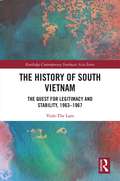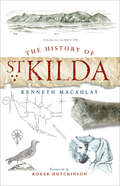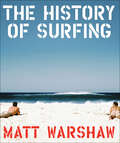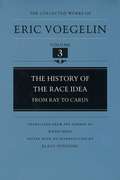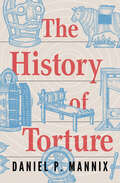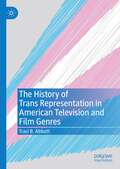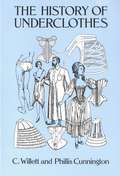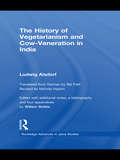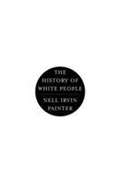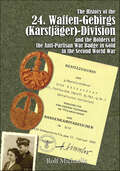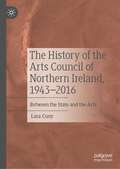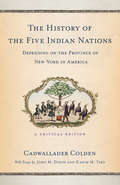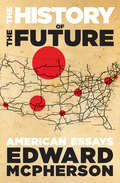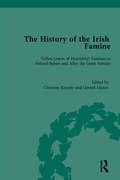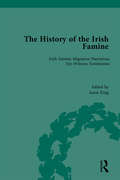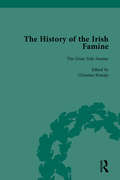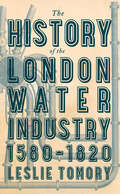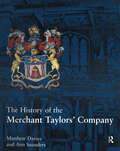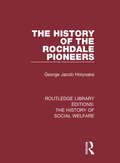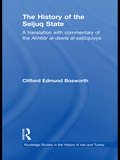- Table View
- List View
The History of South Vietnam - Lam: The Quest for Legitimacy and Stability, 1963-1967 (Routledge Contemporary Southeast Asia Series)
by Vinh-The LamThis book provides an in-depth analysis of the political instability of South Vietnam between the two Republics and offers a valuable contribution to the study of the history of Vietnam as it focuses on a decisive period in the history of South Vietnam. A much-needed examination of the political environment of the Republic of Vietnam between 1963-1967, this book shows how South Vietnamese leadership failed to form a stable civilian government and to secure South Vietnam against the increasing threat by North Vietnam. Through a detailed assessment of political difficulties during the period, the book suggests that, to prevent the imminent loss of South Vietnam to the Communist forces, the United States government did not have any other option than to escalate the war by committing its combat ground forces in the South and beginning the sustained bombing in the North. Moreover, the book analyses the administration of General Khánh and Prime Minister Phan Huy Quát and includes a full account of the War Cabinet of General Nguyễn Cao Kỳ. The achievements, the difficulties and the sudden death of the National High Council as well as the confrontation between the Buddhists and the Trần Vãn Hýõng government are also explored. This book will be of interest to researchers and students of the contemporary history of Vietnam, the history of the Republic of Vietnam, the Vietnam War and Southeast Asian history and politics.
The History of St. Kilda
by Kenneth MacaulayThis classic 18th-century account of the remote Scottish archipelago is a &“beautifully written . . . hugely important piece of social history&” (Scottish Field). As one of the most remote corners of the British Isles, the island archipelago of St Kilda has long held a fascination for travelers from mainland Britain and beyond. Its inhabitants&’ unique culture and way of life has generated an enormous amount of literature for well over a century. Kenneth Macaulay's book, based on his visit to St. Kilda in 1763, is one of the most significant works ever written about the islands. At the time of Macauley&’s visit, St. Kilda&’s population had dwindled to just eighty-eight. His vivid descriptions of the islanders offer rare insight into their living conditions. Macaulay also offers a wealth of information about the animals and birds found there. He writes about the sheep and cattle, and above all the wildfowl, which were used for numerous purposes, including oil, shoes and medicine, and food.
The History of Surfing
by Matt WarshawThis in-depth, photo-packed look at the history and culture of surfers is “meticulously researched, smartly written . . . required reading” (Outside Magazine).Matt Warshaw knows more about surfing than any other person on the planet. After five years of research and writing, Warshaw, a former professional surfer and editor of Surfing magazine, has crafted an unprecedented, definitive history of the sport and the culture it has spawned. With more than 250 rare photographs, The History of Surfing reveals and defines this sport with a voice that is authoritative, funny, and wholly original. The obsessive nature of Warshaw’s endeavor is matched only by the obsessive nature of surfers, who are brought to life in this book in many tales of daring, innovation, athletic achievement, and the offbeat personalities who have made surfing history happen.“The world’s most comprehensive chronicler of the surfing scene.” —Andy Martin, The Independent
The History of The Great Northern Railway: 1845 - 1902 (Routledge Revivals)
by Charles H. GrinlingPublished in 1903, this book provides a complete account of the origin and development of the Great Northern Railway Company from its inception to the year 1802, a period of around 60 years.
The History of The Race Idea: From Ray to Carus (Collected Works of Eric Voegelin #3)
by Ruth Hein Eric Voegelin Klaus VondungIn The History of the Race Idea: From Ray to Carus, Eric Voegelin places the rise of the race idea in the context of the development of modern philosophy. The history of the race idea, according to Voegelin, begins with the postChristian orientation toward a natural system of living forms. In the late seventeenth century, philosophy set about a new task--to oppose the devaluation of man's physical nature. By the middle of the eighteenth century the effort of philosophy was to place man, with his variety of physical manifestations throughout the world, within a systemic order of nature. Voegelin perceives the problem of race as the epitome of the difficulties presented by this new theoretical approach. <p><p> Part I covers the development of race theories from the English naturalist John Ray to Blumenbach and Kant. Voegelin, anticipating fairly recent genetic insights, explains that human beings must be seen as one speciesdifferent races must not be interpreted as emerging from separate species. In Part II, Voegelin discusses the evolution of the concepts of the body, the organism, and the person. The finite image of the person as a body-mind unit in which body is equal to mind in value provides the basis for Carl Gustav Carus' theory of race, the first significant racial ideology, in Voegelin's estimation.<p> Voegelin's complex analysis levels a scathing critique at Nazi pretensions. He writes: "Compared to its classical form, the current condition of race theory is one of decay. . . . [T]hese men, with no eyes for the brilliance of the German spirit, want to interfere in human relations and ultimately presume to explicate the German nation to us and to the world--an undertaking with evil consequences. . . . [The] great thinkers of the past would have been orrified at somebody finding in himself all the traits of the Nordic race with the help of a book on anthropology and then imagining himself to be somebody special who does not have to do anything else.<p> "Let us now take a look at contemporary race theory--we will see an image of destruction. . . . It is a nightmare to think that we should recognize the people whom we follow and whom we allow to come near us not by their looks, their words, and their gestures, but by their cranial index." Ultimately, Voegelin dismisses any attempt to reduce the human being--his existence, appearance, or actionsto a lower level: "Man as mind-body and historical substance cannot be 'explained' by an element that is less than man himself."
The History of Torture
by Daniel P. MannixThe author of The Way of the Gladiator continues his exploration of the dark side of history with this grisly account of pain and punishment through the ages. Human beings have a deep-seated instinct for cruelty, and, so far, have not evolved much past it. History is rife with examples of the infliction of pain used as penalty or execution. In The History of Torture, Daniel P. Mannix takes you from the crucifixions of ancient Rome, to the hanging of women during the Salem witch trials, to the atrocities discovered at Nazi concentration camps. The act of torture has shifted from simple barbarism to advanced psychological techniques thanks to science and technology. Now it&’s not just an actual flogging that will have a prisoner spilling his guts, but law enforcement&’s coercive tactics that might prompt a confession. Follow Mannix as he: leads you into the chambers of Inquisitors, who elevated torture to an art form; illuminates the myriad miseries of the slave trade, America&’s greatest contribution to the torture hall of fame; and explains the most terrible and famous of all Chinese tortures, the Ling-chez or &“death of a thousand cuts.&” No country or culture is spared in this wide-reaching survey of suffering.
The History of Trans Representation in American Television and Film Genres
by Traci B. AbbottDue to the increase in transgender characters in scripted television and film in the 2010s, trans visibility has been presented as a relatively new phenomenon that has positively shifted the cis society’s acceptance of the trans community. This book counters this claim to assert that such representations actually present limited and harmful characterizations, as they have for decades. To do so, this book analyzes transgender narratives in scripted visual media from the 1960s to 2010s across a variety of genres, including independent and mainstream films and television dramatic series and sitcoms, judging not the veracity of such representations per se but dissecting their transphobia as a constant despite relevant shifts that have improved their veracity and variety. Already ingrained with their own ideological expectations, genres shift the framing of the trans character, particularly the relevance of their gender difference for cisgender characters and society. The popularity of trans characters within certain genres also provides a historical lineage that is examined against the progression of transgender rights activism and corresponding transphobic falsehoods, concluding that this popular medium continues to offer a limited and narrow conception of gender, the variability of the transgender experience, and the range of transgender identities.
The History of Underclothes
by C. Willett Cunnington PhiIlis Cunnington". . . thoroughness and most impressive scholarship . . . much entertaining detail and . . . pleasant humour." — The Times Literary Supplement (London)Underwear — practical garments with a utilitarian function or body coverings that serve an erotic purpose? As this fascinating and intelligently written study shows, the role played by underclothing over the last several centuries has been a varied one.In a well-documented, profusely illustrated volume combining impressive scholarship with an entertaining, often humorous style, two distinguished clothing historians consider undergarments worn by the English over the past 600 years. Beginning with the Middle Ages, the authors cover centuries of clothing history, including the Tudor period, the Restoration, the Victorian and Edwardian eras, and the twentieth century up to the eve of World War II. Drawing on extensive, research, the Cunningtons illuminate the role and function of underwear: it protected the wearer against the elements, supported costume shapes, served as an erotic stimulus, symbolized class distinctions, and fulfilled other social, sanitary, and economic functions. Enhancing the detailed, comprehensive text are more than 100 period illustrations and photographs depicting a laced-up bodice of the twelfth century, embroidered linen drawers of the sixteenth century, a hooped petticoat support in bentwood (c. 1750), footed long drawers (1795), nineteenth-century bustles, early nineteenth-century corsets for men, "Frillies for the Tiny Lady" (1939), and much more. A bibliography, appendix, and index complete a valuable reference work that will appeal to costume historians, sociologists, and other readers.
The History of Vegetarianism and Cow-Veneration in India (Routledge Advances in Jaina Studies)
by Ludwig AlsdorfFor the first time, this influential study by Ludwig Alsdorf is made available to an English speaking audience, translated by Bal Patil. It focuses on two of the most pertinent issues in Indian religion, the history of vegetarianism and cow-veneration, and its historical approach remains relevant to this day. With reference to significant brahminical texts, such as key chapters of the Book of Manu, the book centres on the author’s analysis of the role of Jinism in the history of vegetarianism. The author explores the history of meat-eating in India and its relationship to religious thought and custom, and searches for solutions to the problem of cattle veneration. Besides a comprehensive translation of the original German manuscript "Beiträge zur Geschichte von Vegetarismus und Rinderverehrung in Indien", four important articles directly related to Alsdorf’s work by Kapadia, Heesterman and Schmidt are made available in this new edition. These additional contributions and careful notes by the editor Willem Bollée add a modern perspective to a study that remains a key reference for students and scholars of Religious Studies, Asian Studies and History.
The History of White People
by Nell Irvin PainterEver since the Enlightenment, race theory and its inevitable partner, racism, have followed a crooked road, constructed by dominant peoples to justify their domination of others. Filling a huge gap in historical literature that long focused on the non-white, eminent historian Nell Irvin Painter guides us through more than two thousand years of Western civilization, tracing not only the invention of the idea of race but also the frequent worship of "whiteness" for economic, social, scientific, and political ends. Our story begins in Greek and Roman antiquity, where the concept of race did not exist, only geography and the opportunity to conquer and enslave others. Not until the eighteenth century did an obsession with whiteness flourish, with the German invention of the notion of Caucasian beauty. This theory made northern Europeans into "Saxons," "Anglo-Saxons," and "Teutons," envisioned as uniquely handsome natural rulers. Here was a worldview congenial to northern Europeans bent on empire. There followed an explosion of theories of race, now focusing on racial temperament as well as skin color. Spread by such intellectuals as Madame de Stael and Thomas Carlyle, white race theory soon reached North America with a vengeance. Its chief spokesman, Ralph Waldo Emerson, did the most to label Anglo-Saxons-icons of beauty and virtue-as the only true Americans. It was an ideal that excluded not only blacks but also all ethnic groups not of Protestant, northern European background. The Irish and Native Americans were out and, later, so were the Chinese, Jews, Italians, Slavs, and Greeks-all deemed racially alien. Did immigrations threaten the very existence of America? Americans were assumed to be white, but who among poor immigrants could become truly American? A tortured and convoluted series of scientific explorations developed-theories intended to keep Anglo-Saxons at the top: the ever-popular measurement of skulls, the powerful eugenics movement, and highly biased intelligence tests-all designed to keep working people out and down. As Painter reveals, power-supported by economics, science, and politics-continued to drive exclusionary notions of whiteness until, deep into the twentieth century, political realities enlarged the category of truly American. A story filled with towering historical figures, The History of White People forcefully reminds us that the concept of one white race is a recent invention. The meaning, importance, and realty of this all-too-human thesis of race have buckled under the weight of a long and rich unfolding of events.
The History of Women's Mosques in Chinese Islam
by Maria Jaschok Shui Jingjun ShuiThis is a study of Chinese Hui Muslim women's historic and unrelenting spiritual, educational, political and gendered drive for an institutional presence in Islamic worship and leadership: 'a mosque of one's own' as a unique feature of Chinese Muslim culture. The authors place the historical origin of women's segregated religious institutions in the Chinese Islamic diaspora's fight for survival, and in their crucial contribution to the cause of ethnic/religious minority identity and solidarity. Against the presentation of complex historical developments of women's own site of worship and learning, the authors open out to contemporary problems of sexual politics within the wider society of socialist China and beyond to the history of Islam in all its cultural diversity.
The History of the 24. Waffen-Gebirgs (Karstjäger)-Division: and the Holders of the Anti-Partisan War Badge in Gold in the Second World War
by Rolf MichaelisDetailed look into the brutal anti-partisan warfare in Yugoslavia during WWII
The History of the Arts Council of Northern Ireland, 1943–2016: Between the State and the Arts
by Lara CunyThis book presents the history of the Council for the Encouragement of Music and the Arts (CEMA) in Northern Ireland from its conception in 1943, and its successor organisation, the Arts Council of Northern Ireland (ACNI). Exploring the political and social impact of cultural policy in Northern Ireland, the book illustrates how the arts developed during the twentieth century and sheds light on the relationship between politics and culture. The author takes a closer look at the responsibilities of ACNI, and examines its interaction with the unionist government, which sought to influence how the organisation distributed its grants. Spanning the outbreak of the Troubles in the 1960s and the Peace Process in the 1990s, the ACNI evolved through a period of conflict and change, and therefore this book argues that there was an undeniable link between the changing political environment and the management of the arts in Northern Ireland. The arm’s length principle is analysed in relation to ACNI, examining the influence that the state had upon its management and governance. Offering a unique historical overview of the arts in Northern Ireland, this interdisciplinary book fills a gap in Irish history and presents insights into cultural policy, conflict resolution and political history.
The History of the Five Indian Nations Depending on the Province of New-York in America: A Critical Edition
by Cadwallader Colden"How should we approach The History of the Five Indian Nations today? The book's information—rich as it is—should be critically interrogated and placed in social, political, and cultural context. The book reflects the outlook of a colonial British agent and, in a more general sense, of early modern European and Euro-American culture. Its claims of empirical objectivity should be historicized."—John M. Dixon, "Imperial Politics, Enlightenment Philosophy, and Transatlantic Print Culture""The History of the Five Indian Nations remains an invaluable font of information for understanding the Iroquois during the decades before European invaders began to pour into the Longhouse. Colden’s account of Iroquois military and diplomatic exploits is studded with fascinating details. It illuminates internal and external political dynamics as well as the extent and limits of European colonial power. Colden did not necessarily comprehend the cultural logic that guided Iroquois people, but he appreciated them as agents—remarkably audacious ones—in the affairs of all of eastern North America."—Karim M. Tiro, "Iroquois Ways of War and Peace"Cadwallader Colden’s History of the Five Indian Nations Depending on the Province of New-York in America, originally published in 1727 and revised in 1747, is one of the most important intellectual works published in eighteenth-century British America. Colden was among the most learned American men of his time, and his history of the Iroquois tribes makes fascinating reading. The author discusses the religion, manners, customs, laws, and forms of government of the confederacy of tribes composed of the Mohawks, Oneidas, Onondagas, Cayugas, and Senecas (and, later, the Tuscaroras), and gives accounts of battles, treaties, and trade with these Indians up to 1697.Since Cornell University Press first reprinted Colden’s History in 1958, the book has served as an invaluable resource for scholars and students interested in Iroquois history and culture, Enlightenment attitudes toward Native Americans, early American intellectual life, and Anglo-French imperial contests over North America. The new Critical Edition features materials not previously included, such as the 1747 introduction, which contains rich and detailed descriptions of Iroquois culture, government, economy, and society. New essays by John M. Dixon and Karim M. Tiro place The History of the Five Indian Nations Depending on the Province of New-York in America in historical and cultural context and provide a balanced introduction to the historic culture of the Iroquois, as well as their relationship to other Native people.
The History of the Future: American Essays
by Edward McphersonWhat does it mean to think about Dallas in relationship to Dallas? In The History of the Future, McPherson reexamines American places and the space between history, experience, and myth. Private streets, racism, and the St. Louis World’s Fair; fracking for oil and digging for dinosaurs in North Dakota boomtowns-Americana slides into apocalypse in these essays, revealing us to ourselves.
The History of the Incas (Joe R. and Teresa Lozano Long Series in Latin American and Latino Art and Culture)
by Pedro Sarmiento de GamboaThe History of the Incas may be the best description of Inca life and mythology to survive Spanish colonization of Peru. Pedro Sarmiento de Gamboa, a well-educated sea captain and cosmographer of the viceroyalty, wrote the document in Cuzco, the capital of the Inca Empire, just forty years after the arrival of the first Spaniards. The royal sponsorship of the work guaranteed Sarmiento direct access to the highest Spanish officials in Cuzco. It allowed him to summon influential Incas, especially those who had witnessed the fall of the Empire. Sarmiento also traveled widely and interviewed numerous local lords (curacas), as well as surviving members of the royal Inca families. Once completed, in an unprecedented effort to establish the authenticity of the work, Sarmiento’s manuscript was read, chapter by chapter, to forty-two indigenous authorities for commentary and correction. The scholars behind this new edition (the first to be published in English since 1907) went to similarly great lengths in pursuit of accuracy. Translators Brian Bauer and Vania Smith used an early transcript and, in some instances, the original document to create the text. Bauer and Jean-Jacques Decoster’s introduction lays bare the biases Sarmiento incorporated into his writing. It also theorizes what sources, in addition to his extensive interviews, Sarmiento relied upon to produce his history. Finally, more than sixty new illustrations enliven this historically invaluable document of life in the ancient Andes.
The History of the Irish Famine: Fallen Leaves of Humanity: Famines in Ireland Before and After the Great Famine
by Christine Kinealy Gerard MoranThe Great Irish Famine remains one of the most lethal famines in modern world history and a watershed moment in the development of modern Ireland – socially, politically, demographically and culturally. In the space of only four years, Ireland lost twenty-five per cent of its population as a consequence of starvation, disease and large-scale emigration. Certain aspects of the Famine remain contested and controversial, for example the issue of the British government’s culpability, proselytism, and the reception of emigrants. However, recent historiographical focus on this famine has overshadowed the impact of other periods of subsistence crisis, both before 1845 and after 1852. This volume seeks to counterbalance the recent historiographical focus on the Great Irish Famine which has overshadowed the impact of other periods of subsistence crisis, both before 1845 and after 1852. As occurred during the Great Famine, they often resulted in increased levels of evictions, emigration, disease and death, although the scale was lower. While the Great Famine brought major economic, social and demographic changes, large areas of the country retained pre-famine structures with many communities continuing to have a subsistence existence and, consequently, regular crop failures and famines. These lesser known famines are examined in this volume along with the causes and why they did not achieve the scale of the Great Famine.
The History of the Irish Famine: Irish Famine Migration Narratives: Eyewitness Testimonies (Routledge Historical Resources)
by Jason KingThe Great Irish Famine remains one of the most lethal famines in modern world history and a watershed moment in the development of modern Ireland – socially, politically, demographically and culturally. In the space of only four years, Ireland lost twenty-five per cent of its population as a consequence of starvation, disease and large-scale emigration. Certain aspects of the Famine remain contested and controversial, for example the issue of the British government’s culpability, proselytism, and the reception of emigrants. However, recent historiographical focus on this famine has overshadowed the impact of other periods of subsistence crisis, both before 1845 and after 1852. This volume breaks new ground in bringing together foundational narratives of one of Europe and North America’s first refugee crises — making visible their impact in shaping perceptions, public opinion, and patterns of memorialization of Irish forced migration. It documents eyewitness impressions of suffering Irish emigrants, and raises questions about what literary conventions, mnemonic motifs, and popular images can be found in eyewitness accounts, press coverage, and foundational narratives of Famine Irish forced migration. These primary sources provide a model for understanding how representations of forced migration shape public opinion and policy.
The History of the Irish Famine: The Exodus: Emigration and the Great Irish Famine (Routledge Historical Resources)
by Gerard MoranThe Great Irish Famine remains one of the most lethal famines in modern world history and a watershed moment in the development of modern Ireland – socially, politically, demographically and culturally. In the space of only four years, Ireland lost twenty-five per cent of its population as a consequence of starvation, disease and large-scale emigration. Certain aspects of the Famine remain contested and controversial, for example the issue of the British government’s culpability, proselytism, and the reception of emigrants. However, recent historiographical focus on this famine has overshadowed the impact of other periods of subsistence crisis, both before 1845 and after 1852. This volume examines how the failure of the potato crop in the late 1840s led to the mass exodus of 2.1 million people between 1845 and 1855. They left for destinations as close as Britain and as far as the United States, Canada and Australia, and heralded an era of mass migration which saw another 4.5 million leave for foreign destinations over the next half-century. How they left, how they settled in the host countries and their experiences with the local populations are as wide and varied as the numbers who left and, using extensive primary sources, this volume analyses and assesses this in the context of the emigrants themselves and in the new countries they moved.
The History of the Irish Famine: Volume I: The Great Irish Famine
by Christine KinealyThe Great Irish Famine remains one of the most lethal famines in modern world history and a watershed moment in the development of modern Ireland – socially, politically, demographically and culturally. In the space of only four years, Ireland lost twenty-five per cent of its population as a consequence of starvation, disease and large-scale emigration. Certain aspects of the Famine remain contested and controversial, for example the issue of the British government’s culpability, proselytism, and the reception of emigrants. However, recent historiographical focus on this famine has overshadowed the impact of other periods of subsistence crisis, both before 1845 and after 1852. This first volume addresses the questions: when did the famine begin and end; to what extent is the British government after 1846 culpable for the suffering and mortality; how important was philanthropy in alleviating the distress; what was the role and responsibility of Irish elites; is the word famine appropriate given that Ireland continued to export large amounts of food.
The History of the London Water Industry, 1580–1820
by Leslie TomoryThis in-depth study explores the technological, cultural, and mercantile factors behind the infrastructure that transformed early modern London.Beginning in 1580, a number of competing London companies sold water directly to consumers through a large network of wooden mains in the expanding metropolis. This new water industry flourished throughout the 1600s, eventually expanding to serve tens of thousands of homes. By the late eighteenth century, more than 80 percent of the city’s houses had water connections—making London the best-served metropolis in the world while demonstrating that it was legally, commercially, and technologically possible to run an infrastructure network within the largest city on earth.Historian Leslie Tomory shows how an explosion of consumer demand and new technologies imported from the Continent spurred the rapid growth of London’s water industry. Meanwhile, several key local innovations reshaped the industry by enlarging the size of the supply network. By 1800, the success of London’s water industry made it a model for cities across Europe and beyond. It even inspired builders of other large-scale urban projects, including gas and sewage supply networks.
The History of the Merchant Taylors' Company
by Matthew DaviesOne of the 'Great Twelve' livery companies of the City of London, the Merchant Taylors' Company has been in existence for some seven hundred years. This new history will chart the remarkable story of the Company and its members from its origins until the 1950s, encompassing the lives and achievements of men such as Sir Thomas White (founder of St John's College, Oxford) and the celebrated chronicler, John Stow, as well as the roles played by the Company in the City and beyond in different periods. As well as looking in detail at the internal life of the Company, the book will also focus on a number of important themes in the wider history of London. These include trade and industry, apprenticeship, the impact of religious change, the foundation of schools and other charities, and the government and politics of the City. In doing so, the book will contribute to an understanding of the aims and activities of the livery companies over the centuries, their ability to adapt to changing circumstances and their relevance in a modern world far removed from that in which they were first established. The History of the Merchant Taylors' Company will appeal to a wide range of people interested in the history of London. It is fully illustrated with more than seventy-five black and white and thirty colour illustrations.
The History of the Merchant Taylors' Company
by Matthew DaviesOne of the 'Great Twelve' livery companies of the City of London, the Merchant Taylors' Company has been in existence for some seven hundred years. This new history will chart the remarkable story of the Company and its members from its origins until the 1950s, encompassing the lives and achievements of men such as Sir Thomas White (founder of St John's College, Oxford) and the celebrated chronicler, John Stow, as well as the roles played by the Company in the City and beyond in different periods. As well as looking in detail at the internal life of the Company, the book will also focus on a number of important themes in the wider history of London. These include trade and industry, apprenticeship, the impact of religious change, the foundation of schools and other charities, and the government and politics of the City. In doing so, the book will contribute to an understanding of the aims and activities of the livery companies over the centuries, their ability to adapt to changing circumstances and their relevance in a modern world far removed from that in which they were first established. The History of the Merchant Taylors' Company will appeal to a wide range of people interested in the history of London. It is fully illustrated with more than seventy-five black and white and thirty colour illustrations.
The History of the Rochdale Pioneers (Routledge Library Editions: The History of Social Welfare #9)
by George Jacob HolyoakeFirst published in 1893, this tenth edition of The History of the Rochdale Pioneers, is an example of the nineteenth-century tradition of self-help manuals. It describes the origins and the development of the Rochdale Equitable Pioneers Society, the problems faced by the Rochdale Pioneers through economically tough times and how the collective were able to overcome these difficulties. This book will be of interest to those studying the history of social welfare, class and economics, as well as the Co-operative Movement.
The History of the Seljuq State: A Translation with Commentary of the Akhbar al-dawla al-saljuqiyya (Routledge Studies in the History of Iran and Turkey)
by Clifford Edmund BosworthThe Akhbar al-dawla al-saljuqiyya is one of the key primary documents on the history of Western Persia and Iraq in the 11th and 12th centuries. This book provides an accessible English translation and commentary on the text, making available to a new readership this significant work on the pre-modern history of the Middle East and the Turkish peoples. The text is a chronicle of the Seljuq dynasty as it emerged within the Iranian lands in the 11th and 12th centuries, dominating the Middle Eastern lands, from Turkey and Syria to Iran and eastern Afghanistan. During this formative period in the central and eastern Islamic lands, they inaugurated a pattern of Turkish political and military dominance of the Middle East and beyond, from Egypt to India, in some cases well into the 20th century. Shedding light on many otherwise obscure aspects of the political history of the region, the book provides a more detailed context for the political history of the wider area. As such, it will be of great interest to scholars of Middle Eastern history and is an important addition to the existing literature on the Seljuq dynasty.
